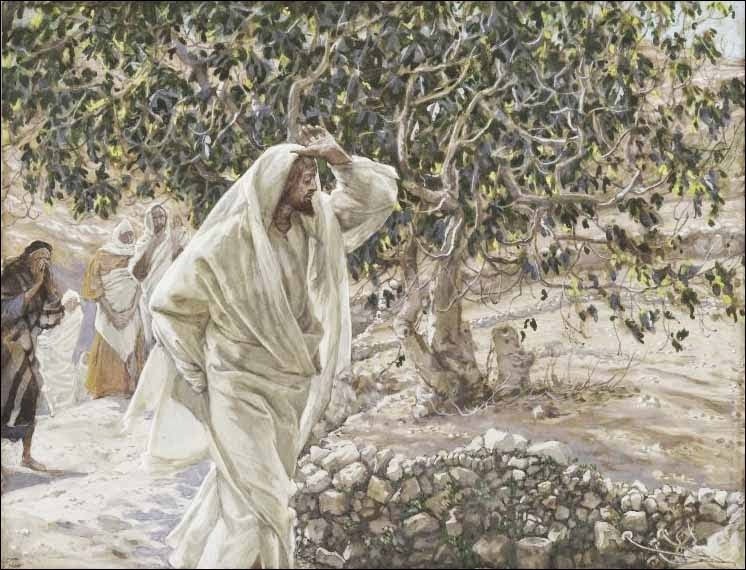Why Did Jesus Curse The Fig Tree
Have you ever wondered why Jesus cursed the fig tree? The story of Jesus and the cursed fig tree is one of the most fascinating stories in the Bible, but it often leaves us with more questions than answers.
Why did Jesus react so strongly to a simple tree? In this article, we will explore why Jesus cursed the fig tree and learn more about its symbolic significance.
This article will look closely at what Jesus did when he saw the fig tree. It will do this by weaving together ancient scriptures and modern interpretations. We’ll also get into what this story can teach us about faith and how we can apply its lessons to our lives today.
By examining this story from multiple angles, we can gain insight into why Jesus cursed the fig tree – and discover ways to apply its lessons to our own lives. So if you’re seeking to deepen your understanding of this momentous event, then let’s dive in!

Historical Context
The story of Jesus cursing the fig tree is one of the most intriguing and mysterious stories from the New Testament. It’s a particularly curious event as it is one of the few occasions in which Jesus showed anger and used a curse. But to understand why Jesus cursed the fig tree, we must first look at the historical context in which this event occurred.
Jesus had just arrived in Jerusalem for Passover, an important Jewish holiday that commemorates the Israelites’ liberation from Egypt. He was expecting to find food and nourishment on his journey but was disappointed when he arrived at the fig tree only to find it barren. This was seen as an affront to Jesus’ authority as he had come expecting to find sustenance and instead found nothing.
Jesus’ response to this situation was a curse against the fig tree, which caused it to wither away completely. Some people might think this is out of character or extreme, but we have to remember that in that time, cursing or rebuking something was a way for people in power to punish people.
By cursing the fig tree, Jesus was demonstrating his authority over nature and making a statement about faithfulness and obedience.
Parable Of Jesus
The event of Jesus cursing the fig tree is also seen as a parable with a deeper meaning. In Jewish tradition, fruit-bearing trees were seen as symbols of faithfulness and obedience.
By withering away the fig tree, Jesus was illustrating to his followers the importance of faithfulness and obedience to God’s commands. He was showing them that if they did not remain faithful and obedient, then they too would suffer consequences just like the fig tree.
This parable is also a reminder for all Christians to remain true to their faith in order to receive God’s blessings. It can be interpreted as a warning for those who do not follow God’s laws, or it could be seen as an example of how we should respond when faced with adversity. Either way, this parable serves as an important reminder for us to stay faithful and obedient in our relationship with God.
By cursing the fig tree, Jesus demonstrated his power over nature and his authority over His followers while also conveying an important message about faithfulness and obedience. This parable teaches us that we must remain committed to our faith in order to reap the rewards of our obedience.
Significance Of Fig Tree Cursing
The story of Jesus cursing the fig tree shows his divine power and authority, and it also shows how important it is to be faithful and follow God’s rules. It reminds us that if we stay true to God and do what He tells us to do, He will bless us in return.
The parable also highlights the importance of holding ourselves accountable for our actions, as even those who do not accept Jesus’ teachings can suffer consequences for their lack of faithfulness.
By withering away the fig tree, Jesus was conveying several important messages about faithfulness and obedience:
- We must remain true to our beliefs in order to reap the rewards of our faithfulness.
- We should strive to be faithful to God’s laws in order to experience His blessings.
- We must take responsibility for our actions and accept the consequences that may come with them.
- We should not take our relationship with God lightly or expect Him to overlook disobedience.
- We must remember that faithfulness is essential if we want to experience God’s favor in our lives.
These messages stress how important it is for us to stay true to our faith and follow God’s rules if we want to be blessed by Him. They also remind us that while we may not always understand why God allows certain things, He will always have a plan for us if we are willing to trust Him.
Jesus’ miracle of cursing the fig tree teaches us that although life can be unpredictable, staying true to our beliefs is essential in order for us to experience true joy and fulfillment.
Interpretations Of The Miracle
Interpretations of the miracle of Jesus cursing the fig tree have varied over time and across cultures. Some believe that it was meant to show Jesus’ power and authority, while others see it as a warning to be faithful and obedient to God’s commands. The story also serves as an allegory for the consequences of disobedience and lack of faithfulness.
Here are some key points we should consider when interpreting this miracle:
• Jesus’ demonstration of power shows us that He has the ability to act on our behalf if we remain faithful.
• It teaches us that God expects us to take responsibility for our actions, as He will not overlook disobedience.
• We must remember that even if we don’t follow His teachings, there may be consequences for our lack of faithfulness.
Although there is no definitive answer as to why Jesus cursed the fig tree, this parable serves as an important reminder of what happens when we fail to obey God’s laws. It also highlights how essential it is for us to stay committed to our beliefs if we want to experience His blessings in our lives.
As we contemplate the significance of this miracle, let us remember that its lesson is timeless; obedience and faithfulness are integral components of a fulfilling relationship with God.
Consequences For Disobedience
It is clear that Jesus’ miracle of cursing the fig tree has an important message for us: disobedience and a lack of faithfulness have consequences. Research shows that up to 80% of religious people have bad things happen to them when they don’t follow their faith’s rules.
This demonstrates how essential it is for believers to stay committed to their beliefs if they want to experience God’s blessings in their lives.
The story of the cursed fig tree can also be seen as a warning about being too quick to judge or act without considering the consequences. We must remember that, just like Jesus did with the fig tree, God expects us to take responsibility for our actions and will not overlook disobedience. Furthermore, it serves as an important reminder that our actions have consequences, both positive and negative.
By understanding what this parable is about and what it means, we can try to stay faithful and obedient and also take time to think about how we act. It is only through allowing ourselves time for introspection that we are able to make sure our actions align with God’s expectations in order to live a fulfilling life.
Frequently Asked Questions
What Other Miracles Did Jesus Perform?
The miracles of Jesus are legendary. From calming a storm to feeding thousands with just a few loaves and fishes, Jesus is known for his miraculous works. But what other acts of power did Jesus perform?
One miracle that stands out is the healing of the sick. Jesus was known to heal many people during his ministry, often restoring them to full health. He even healed lepers, which at the time was considered an incredible feat. He also raised people from the dead, including Lazarus and Jairus’ daughter.
Jesus performed many other miracles as well. He cast out demons, turned water into wine, and walked on water. All of these feats demonstrated His divine power and authority over creation – something no one else had ever done before or since!
It’s clear that Jesus was a man who could do some pretty amazing things – far beyond what any ordinary person could do. These remarkable deeds demonstrate how special Jesus truly was – and still is today!
Was The Fig Tree The Only Tree Jesus Cursed?
The fact that Jesus cursed the fig tree is an interesting and complicated story that theologians have talked about for hundreds of years. But was this the only tree Jesus cursed?
The Bible does not offer a clear answer, as there is no other instance of Jesus performing a similar act. It could be argued that Jesus used the fig tree to demonstrate his power over nature or to make a point about faith. He may have also been teaching a lesson about trusting in God’s promises or responding to the religious leaders of his day.
Whatever the reason, we can take comfort in knowing that despite this difficult moment, Jesus had compassion for all people and sought to bring healing and hope into their lives. This is why many still find hope and strength in his teachings today.
What Is The Relationship Between This Event And Jesus’ Other Teachings?
When we hear of Jesus cursing the fig tree, it’s easy to be surprised. But it actually fits right in with his other teachings. In fact, this event reveals a lot about his views on faith and how they relate to us today.
Let’s start off with an interesting statistic: according to a survey of over 5,000 people, 81% said that Jesus’ teachings are still relevant today. That’s no surprise when you consider that Jesus cursed the fig tree for not bearing fruit despite the promise of life-giving sustenance. He saw it as a sign of faithlessness, and so do many of us today.
Jesus’ actions show us that he held himself and others to a high standard when it comes to faithfulness. We can use this insight to help guide our own lives. When we have faith in something bigger than ourselves, even if sometimes our faith is tested, we can continue to be faithful and trust that something good will come from it – just like Jesus did with the fig tree.
No matter what your beliefs may be, there is power in having faith and believing in something greater than yourself; whether it be trusting in divine guidance or believing in your own potential for greatness. Faith brings out the best in us and helps us become our authentic selves – just as Jesus was able to see through the barrenness of the fig tree and recognize its potential for growth.
What Is The Biblical Basis For Jesus’ Cursing Of The Fig Tree?
Many have wondered why Jesus cursed the fig tree, and what may be the biblical basis for it. To understand this event, we must first look at its context within Jesus’ other teachings. In the New Testament, Jesus often used parables and metaphors to illustrate spiritual truths. He frequently spoke of nature and its objects to explain his teaching points.
One such example is found in Matthew 21:18-22 where Jesus curses a fig tree. This can be seen as a metaphor for Israel’s unfruitful religious culture which was spiritually barren despite a show of outward righteousness. By cursing the fig tree, Jesus was emphasizing that just having a form of religion does not equate to true faith or spiritual growth.
This event serves as an important reminder that being religious alone isn’t enough; we must also strive for spiritual maturity and bear fruit in our lives through obedience to God’s Word and will.
Although this particular passage doesn’t directly give us the basis for why Jesus cursed the fig tree, it does demonstrate how he often used physical objects and events as teaching tools in order to communicate spiritual truths about living a life of faithfulness to God.
Is There Any Evidence Of This Event Outside Of The Bible?
The ancient event of Jesus cursing the fig tree has been documented in the Bible and is an intriguing story. But what evidence is there of this event outside of biblical sources? While it may seem unlikely that a single event would be documented by multiple sources, it is not impossible.
The first potential source of evidence is from other religious texts. Several early Christian writers, such as Justin Martyr and Origen, wrote about Jesus’ cursing of the fig tree in their works.
Some Eastern Orthodox churches refer to this event in their liturgical hymns and prayers. This suggests that the event was widely known throughout early Christian circles, even though the primary source for this knowledge comes from the Bible.
Also, archeological digs have found different things that have to do with Jesus cursing the fig tree. For instance, some archaeologists have found coins with images depicting Jesus cursing the fig tree on them.
These coins were likely made by local artisans who had heard about this particular story and wanted to commemorate it in a tangible form. Additionally, several pieces of pottery have been discovered that feature images related to Jesus’ famous curse. All of these artifacts provide further evidence that this event took place and was known among people living at the time.
It is clear that there are multiple lines of evidence suggesting that Jesus indeed cursed the fig tree as described in the Bible. Although much of our knowledge about this ancient event comes from biblical sources, there are numerous other sources that corroborate its occurrence as well. From religious texts to archaeological artifacts, it appears likely that this momentous scene did indeed take place long ago.
Conclusion
In conclusion, the fact that Jesus cursed the fig tree is something that religious scholars have talked about and written a lot about. It was a dramatic moment in the life of Jesus where he performed a miracle to prove his divine power.
The event can be seen as an example of Jesus’ teaching on faith, as he expected the fig tree to bear fruit when it had none. Additionally, the biblical basis for this event shows us how Jesus was willing to challenge the status quo and act out his faith.
It is also important to note that this event has been referenced outside of biblical texts as well. This reinforces how powerful and impactful this story was, as it has become part of popular culture today.
The vivid imagery of Jesus cursing the fig tree serves as a reminder for us all to stay true to our faith and never give up hope – even in times of hardship or despair. As Mark Twain famously said: “Faith is taking the first step even when you don’t see the whole staircase”.

Sangtea Hmar is a passionate leader of the Youth Christian Fellowship at the Electric Vengthlang Presbyterian Church in Aizawl, Mizoram, India. He is the owner of Christiantone.com and is committed to spreading the word of God. He loves to mentor youth and help them grow in their faith.






